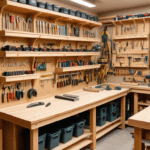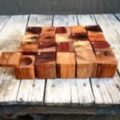The Charm and Chaos of Woodworking Books from the UK
You know, I never really thought I’d end up diving into woodworking. But here I am, sitting in my garage—which is now half workshop and half cluttered horror show—sipping my cold cup of coffee, and wondering how I got into this whole mess.
It started out innocuously enough. I was scrolling through some online markets, totally immersed in my usual distraction of old tools and lumber, when I stumbled upon a few woodworking books from the UK. They had these beautiful covers, and the titles were so… fancy. Something about the combination of British charm and practical advice just hooked me. Naturally, I went down that rabbit hole like Alice in Wonderland, and before I knew it, I had four books on their way to my mailbox.
Now, when those books arrived, I was practically giddy. There was one book, “The Complete Manual of Woodworking” by Albert Jackson, that smelled like a library—those old paper pages that just scream knowledge. Only, I gotta admit, the first project I decided to tackle was a total disaster. A wooden bench. Sounds simple, right?
The Bench That Nearly Broke Me
Armed with my beloved circular saw, which still has splinters from trying to cut through some pine, I was ready to jump into this, not really seeing the irony of thinking I was a professional after reading a few pages. I picked up some lovely pine at the local Home Depot; it had a sweet, almost creamy smell to it. I can still recall that moment—the bright yellow lumber stacked neatly under those harsh fluorescent lights.
Well, here comes the fun part. I misread the dimensions for the bench. I thought I had it all figured out; I was imagining my family sitting around it, eating burgers in the backyard. Turns out, I cut the pieces too short. Like, way too short. And let me tell you, there’s nothing worse than standing there with your awkwardly sized pieces of wood, realizing you just wasted a fine slab of pine that could’ve been the centerpiece of summer cookouts. I almost gave up right then and there.
The Epiphany
But then, I laughed—because honestly, what else could I do? I looked at those tiny pieces of wood and thought, “Well, maybe I can make a kids’ table or something.” So, I pulled my old sander out of the corner of the garage, the one I’d picked up secondhand—there’s always those slight dents and scratches, but it still got a good hum to it. And you know what? I just started sanding without much thought on how it’d turn out. The sound of the wood dust swirling around, mixing with my coffee aroma, somehow gave me clarity.
After losing a couple of hours to sanding, I began piecing together my “kids’ table.” And, wouldn’t you know it, it actually worked! I mean, it wasn’t perfect—but let’s be honest, is anything ever perfect in woodworking? I kinda liked the charm of the crooked legs and the uneven top, and it earned some giggles from my niece when she saw it.
Lessons from the Books
The beautiful thing about those UK woodworking books is how they convey a sense of community and tradition. I stumbled across another gem tucked in one of them, “The Essential Woodworker” by Robert Wearing. The way he talked about the joy and irritation of working with different woods made me feel connected, like we were sharing a late-night whiskey and swapping stories by the fire.
Wearing goes deep into the specifics of wood types, and I remember the way he described oak—the rich smell and that satisfying thump when you hit it just right. I learned a lot from him about how wood moves, swells, and shifts. I realized I was approaching my projects like a bull in a china shop instead of respecting the materials I was working with.
Grateful for Imperfections
And to be honest, it’s the imperfections that give this whole thing a heartbeat. Like that time I tried to stain a small shelf—also pine, of course—and ended up with this blotchy mess. But instead of cursing and starting again, I decided to lean into that chaos. I painted over it, slapped on some bright yellow, and you know what? It turned into this funky little piece that actually got a compliment from a neighbor.
It’s not always easy—not by a long shot. I’ve had to learn to embrace the mistakes instead of seeing them as failures. Each mishap teaches me something new, whether it’s about measurements or how to deal with stubborn screws, the ones that seem to mock you as you wrestle with them.
The Warm Takeaway
So, if you’re thinking of grabbing a woodworking book or two, especially from the UK, just do it. Pour yourself a cup of joe, dive into those pages, and let yourself get messy. You might end up with something that’s more beautiful than you ever planned. And trust me, if you mess it up, don’t worry. You’ll have a funny story to tell later—and who knows? You may just end up creating something unexpected that brings joy to someone else.
At the end of the day, it’s all about the journey—not just the outcome. So embrace the mess, learn from it, and find joy in the unexpected. You’ll thank yourself later.









